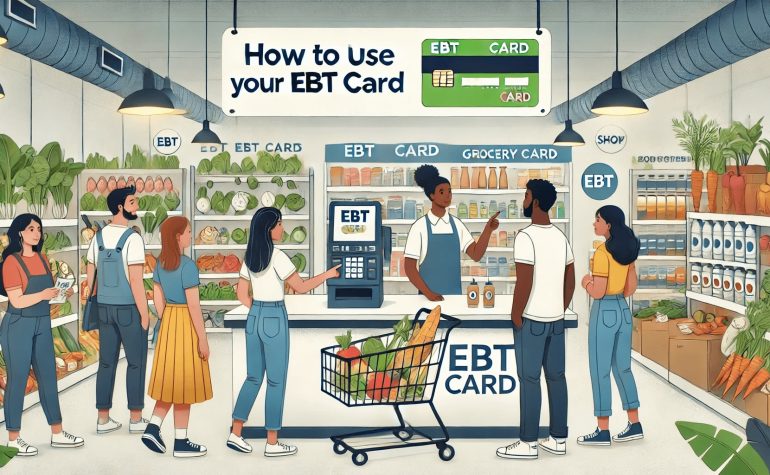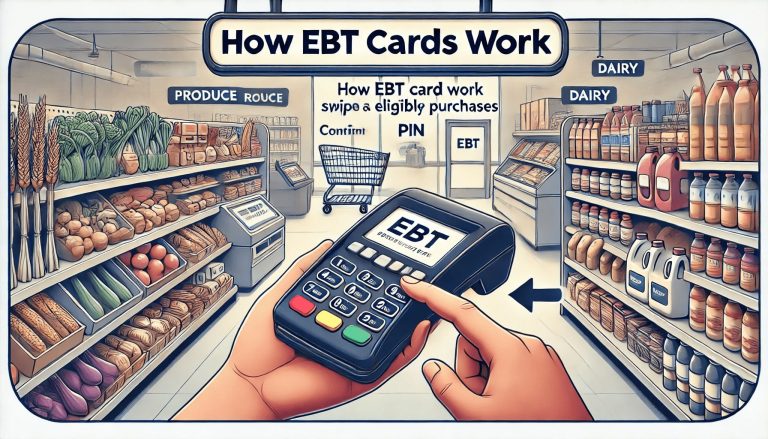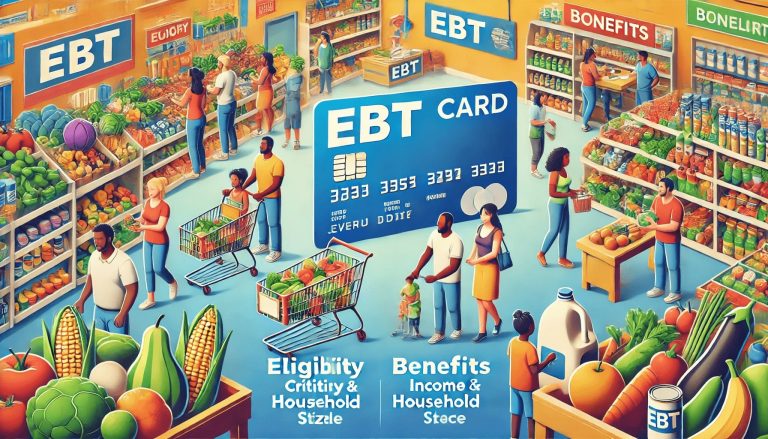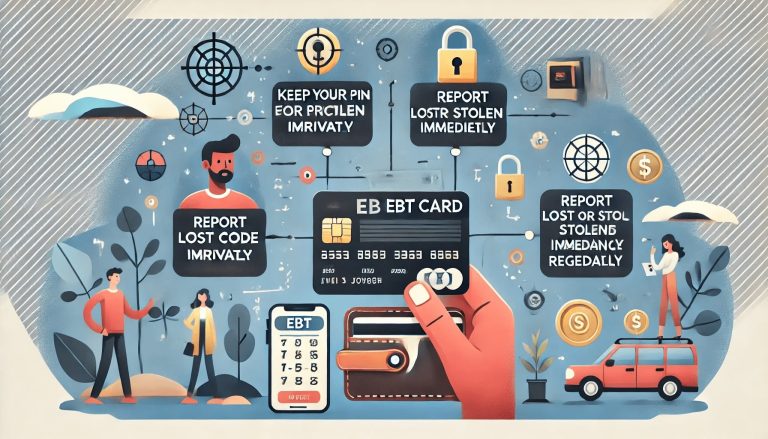
By manoj November 27, 2024
In today’s modern world, electronic benefits transfer (EBT) cards have become an essential tool for millions of low-income individuals and families to access vital food assistance programs. EBT cards, also known as SNAP cards or food stamp cards, provide a convenient and secure way for eligible individuals to purchase groceries and other essential items. However, many customers may not be fully aware of how to effectively use their EBT cards or maximize their benefits.
In this comprehensive guide, we will explore the basics of EBT cards, how they work, eligibility criteria, tips for safeguarding and protecting your card, common challenges and solutions, smart shopping strategies, utilizing EBT cards at different retailers and farmers markets, online purchases and delivery options, and address frequently asked questions.
How EBT Cards Work: A Step-by-Step Guide

Understanding how EBT cards work is crucial for customers to make the most of their benefits. EBT cards function similarly to debit cards, allowing cardholders to make purchases at authorized retailers. The process begins with the issuance of an EBT card to eligible individuals by their state’s Department of Social Services or equivalent agency. Once the card is received, it must be activated by calling a toll-free number or visiting a designated website.
To use the EBT card, cardholders must first select a Personal Identification Number (PIN) to ensure the security of their benefits. This PIN is entered into a point-of-sale (POS) machine at the checkout counter, along with the card itself. The POS machine verifies the card’s validity and available balance before deducting the purchase amount from the cardholder’s account. It is important to note that EBT cards can only be used for eligible food items and cannot be used for non-food items such as alcohol, tobacco, or household supplies.
Benefits and Eligibility Criteria for EBT Cardholders

EBT cards are primarily associated with the Supplemental Nutrition Assistance Program (SNAP), which provides food assistance to low-income individuals and families. Eligibility for SNAP benefits is determined by factors such as income, household size, and expenses. Each state has its own specific guidelines, but generally, households with incomes at or below 130% of the federal poverty level are eligible for SNAP benefits.
The amount of benefits received through SNAP varies depending on factors such as income, household size, and expenses. On average, SNAP benefits provide approximately $1.40 per meal per person. These benefits are loaded onto the EBT card on a monthly basis, allowing cardholders to purchase food items at authorized retailers.
In addition to SNAP benefits, some states also offer other assistance programs that can be accessed through the EBT card. These programs may include cash assistance, Women, Infants, and Children (WIC) benefits, and Temporary Assistance for Needy Families (TANF) benefits. It is important for cardholders to familiarize themselves with the specific programs available in their state to fully utilize their EBT card.
Essential Tips for Safeguarding and Protecting Your EBT Card

Protecting your EBT card is crucial to prevent unauthorized use and ensure the security of your benefits. Here are some essential tips to safeguard your EBT card:
- Keep your EBT card in a safe place: Treat your EBT card like cash and keep it in a secure location. Avoid leaving it unattended or lending it to others.
- Memorize your PIN: Never write down your PIN or share it with anyone. Memorize it to prevent unauthorized access to your benefits.
- Be cautious at the checkout counter: When using your EBT card at a retailer, be mindful of your surroundings and ensure that your PIN is entered discreetly.
- Report lost or stolen cards immediately: If your EBT card is lost or stolen, report it to your state’s EBT customer service hotline immediately. This will prevent unauthorized use and allow for a replacement card to be issued.
- Regularly check your account balance: Keep track of your EBT card balance by checking it regularly either online, through a mobile app, or by calling the customer service hotline. This will help you monitor your benefits and detect any unauthorized transactions.
- Be cautious of phishing scams: Be wary of unsolicited calls, emails, or text messages asking for your EBT card information. Legitimate agencies will never ask for your PIN or personal information over the phone or through email.
- Keep your personal information up to date: Notify your state’s EBT customer service if there are any changes to your address or contact information. This will ensure that important notifications and updates are sent to the correct address.
By following these essential tips, EBT cardholders can protect their benefits and minimize the risk of fraud or unauthorized use.
Navigating the EBT Card System: Common Challenges and Solutions
While EBT cards provide a convenient way to access food assistance programs, there can be challenges in navigating the system. Understanding these challenges and their solutions can help EBT cardholders overcome any obstacles they may encounter. Here are some common challenges and their solutions:
- Retailer acceptance: Not all retailers accept EBT cards, which can limit the options for cardholders. However, most major grocery store chains and supermarkets are authorized to accept EBT cards. It is important to familiarize yourself with the authorized retailers in your area to ensure you can access your benefits.
- Technical issues at the point of sale: Occasionally, technical issues may arise at the point of sale, preventing the EBT card from being processed. In such cases, it is advisable to inform the cashier or store manager, who can help resolve the issue or provide alternative payment options.
- Limited access to healthy food options: Some low-income neighborhoods may have limited access to fresh and healthy food options, commonly known as food deserts. In such cases, cardholders can explore alternative options such as farmers markets, community-supported agriculture (CSA) programs, or online grocery delivery services that accept EBT cards.
- Language barriers: Language barriers can pose challenges for non-English speaking EBT cardholders. To overcome this, many states provide multilingual customer service hotlines and informational materials in different languages. Cardholders can also seek assistance from community organizations or social service agencies that offer language support.
- EBT card balance management: Managing the EBT card balance can be challenging, especially towards the end of the month when benefits may be running low. To address this, cardholders can plan their purchases, compare prices, and prioritize essential items to make the most of their benefits. Additionally, some states offer nutrition education programs that provide tips on budgeting and healthy eating on a limited budget.
By being aware of these common challenges and their solutions, EBT cardholders can navigate the system more effectively and make the most of their benefits.
Maximizing Your EBT Benefits: Smart Shopping Strategies
Making the most of your EBT benefits involves adopting smart shopping strategies that help stretch your dollars and maximize the value of your purchases. Here are some tips to help you make wise choices while shopping with your EBT card:
- Plan your meals and create a shopping list: Before heading to the grocery store, plan your meals for the week and create a shopping list. This will help you avoid impulse purchases and ensure that you buy only what you need.
- Compare prices and look for deals: Compare prices at different stores to find the best deals and discounts. Consider shopping at discount stores, farmers markets, or stores that offer loyalty programs to save money.
- Buy in bulk: Purchasing non-perishable items in bulk can be cost-effective. Look for bulk options for items such as rice, pasta, canned goods, and frozen vegetables.
- Utilize coupons and discounts: Take advantage of coupons and discounts to save money on your purchases. Many stores offer digital coupons that can be loaded onto your EBT card, allowing you to redeem them at checkout.
- Prioritize nutritious and affordable foods: Focus on purchasing nutritious foods that provide the most value for your money. Fresh fruits and vegetables, whole grains, lean proteins, and dairy products are all essential components of a healthy diet.
- Consider seasonal and local produce: Seasonal and local produce is often more affordable and fresher than imported options. Visit farmers markets or consider joining a CSA program to access a variety of fresh, locally grown produce.
- Learn to cook and prepare meals at home: Cooking meals at home is generally more cost-effective than eating out. Invest in basic cooking skills and explore simple, budget-friendly recipes to make the most of your EBT benefits.
- Avoid convenience foods and processed snacks: Convenience foods and processed snacks are often more expensive and less nutritious than homemade alternatives. Opt for whole foods and ingredients to save money and improve your overall health.
- Store and preserve food properly: Properly storing and preserving food can help reduce waste and extend its shelf life. Learn about proper storage techniques for different types of food to avoid spoilage and maximize your purchases.
- Take advantage of nutrition education programs: Many states offer nutrition education programs that provide valuable information on healthy eating, meal planning, and budgeting. These programs can help you make informed choices and maximize the nutritional value of your purchases.
By implementing these smart shopping strategies, EBT cardholders can make their benefits go further and ensure a nutritious and balanced diet for themselves and their families.
Utilizing EBT Cards at Different Retailers and Farmers Markets
EBT cards can be used at a variety of authorized retailers, including major grocery store chains, supermarkets, and farmers markets. Understanding how to utilize your EBT card at different types of retailers can help you access a wider range of food options. Here’s a breakdown of how EBT cards can be used at different retailers:
- Grocery store chains and supermarkets: Most major grocery store chains and supermarkets accept EBT cards. Cardholders can shop for a wide variety of food items, including fresh produce, dairy products, meat, poultry, seafood, bread, cereals, and canned goods. It is important to note that EBT cards cannot be used for non-food items such as alcohol, tobacco, or household supplies.
- Farmers markets: Many farmers markets now accept EBT cards, allowing cardholders to purchase fresh, locally grown produce directly from farmers. Some farmers markets even offer incentives such as matching funds or bonus dollars, which can increase the purchasing power of EBT benefits. To find farmers markets that accept EBT cards in your area, you can visit the USDA’s Farmers Market Directory or check with your state’s Department of Agriculture.
- Community-supported agriculture (CSA) programs: CSA programs allow individuals to purchase a share of a local farm’s produce for a season. Some CSA programs accept EBT cards, making it easier for cardholders to access fresh, locally grown produce. By joining a CSA program, cardholders can receive a weekly or bi-weekly box of seasonal produce directly from the farm.
- Online grocery delivery services: In recent years, some online grocery delivery services have started accepting EBT cards. This allows cardholders to shop for groceries online and have them delivered to their doorstep. Online grocery delivery services can be particularly beneficial for individuals with limited mobility or those living in food deserts.
When utilizing your EBT card at different retailers, it is important to familiarize yourself with their specific policies and procedures. Some retailers may have restrictions on certain items or require additional identification. By understanding the guidelines and requirements, you can ensure a smooth and hassle-free shopping experience.
EBT Card Usage: Online Purchases and Delivery Options
In response to the COVID-19 pandemic, the United States Department of Agriculture (USDA) has expanded the use of EBT cards to include online purchases. This allows EBT cardholders to shop for groceries online and have them delivered to their homes. Here’s a closer look at EBT card usage for online purchases and delivery options:
- Online purchasing pilot programs: The USDA has launched online purchasing pilot programs in select states to test the feasibility and effectiveness of online EBT transactions. As of 2021, over 47 states and the District of Columbia have implemented online purchasing programs, with more states expected to join in the future.
- Participating online retailers: EBT cardholders can use their cards to shop for groceries online at participating retailers. Retailers such as Amazon, Walmart, and FreshDirect are among the major online platforms that accept EBT cards. It is important to note that not all items available on these platforms are eligible for purchase with EBT benefits. Cardholders should look for the “SNAP-eligible” label or filter options to ensure they are selecting eligible items.
- Delivery options: Online grocery delivery services offer various delivery options to suit different needs. Some services offer doorstep delivery, while others allow for in-store pickup. Cardholders can choose the option that is most convenient for them, considering factors such as location, availability, and delivery fees.
- Delivery fees and minimum order requirements: It is important to be aware of any delivery fees or minimum order requirements associated with online grocery purchases. Some retailers may offer free delivery for EBT cardholders, while others may charge a nominal fee. Additionally, some retailers may require a minimum order amount to qualify for delivery.
- EBT card payment process: When making online purchases with an EBT card, cardholders will need to enter their card information during the checkout process. This typically involves selecting the EBT payment option, entering the card number, and providing the PIN. It is important to ensure that the website or app is secure and reputable before entering any personal or financial information.
- SNAP benefits and online purchasing limits: SNAP benefits cannot be used to pay for delivery fees or other non-food items. Additionally, there may be limits on the amount of SNAP benefits that can be used for online purchases. Cardholders should familiarize themselves with the specific guidelines and restrictions in their state to ensure compliance.
By utilizing online purchasing and delivery options, EBT cardholders can access a wider range of food options, especially during times when in-person shopping may be challenging or limited.
Frequently Asked Questions (FAQs)
To further educate customers on using EBT cards, it is important to address common questions and concerns. Here are some frequently asked questions and their answers:
Q1. Can I use my EBT card to withdraw cash?
Yes, EBT cards can be used to withdraw cash at ATMs that accept EBT cards. However, it is important to note that cash withdrawals may be subject to fees, so it is advisable to check with your state’s EBT program for specific details.
Q2. Can I use my EBT card in other states?
Yes, EBT cards can be used in any state, as long as the retailer accepts EBT payments. However, it is important to note that certain restrictions may apply, such as different eligible items or benefit amounts.
Q3. Can I use my EBT card to purchase hot food?
In most cases, EBT cards cannot be used to purchase hot food items prepared for immediate consumption. However, there are exceptions for certain populations, such as elderly, disabled, or homeless individuals. Check with your state’s EBT program for specific guidelines.
Q4. Can I transfer my EBT benefits to someone else?
No, EBT benefits are non-transferable and can only be used by the eligible cardholder. It is illegal to sell or trade EBT benefits.
Q5. What should I do if my EBT card is not working?
If your EBT card is not working, first check if you have sufficient funds and if the retailer accepts EBT payments. If the issue persists, contact the EBT customer service hotline for assistance.
Conclusion
Educating customers on using EBT cards is crucial to ensure they can effectively access and utilize their government assistance benefits. By understanding the basics of EBT cards, how they work, and the benefits they provide, cardholders can make informed decisions and improve their overall well-being.
Additionally, by following essential tips for safeguarding and protecting their EBT cards, customers can prevent fraud and unauthorized use. By providing comprehensive information, addressing frequently asked questions, and promoting responsible card usage, we can empower EBT cardholders to make the most of their benefits and improve their quality of life.